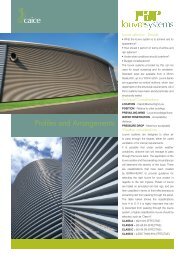CAICE Attenuator
CAICE Attenuator
CAICE Attenuator
You also want an ePaper? Increase the reach of your titles
YUMPU automatically turns print PDFs into web optimized ePapers that Google loves.
C - 30mm Profile Flanges formed on an automated duct line from the parent metal of the casing, and fitted with one or two piece<br />
flange corners (LG, SG, MG - RG and BG models also available but fitted with 30mm MEZ flanges).<br />
D - Rectangular Spigot End Caps fitted to each end of the attenuator, where the rectangular spigot is generally smaller than the<br />
casing width and height. This enables elements to be provided out of air stream if required to minimise pressure loss (LG).<br />
E - Circular Spigot End Caps fitted to each end of the attenuator, where the circular spigot is smaller than the casing width and<br />
height. This enables elements to be provided out of air stream if required to minimise pressure loss (LG).<br />
F - 20mm Profile Flange at one end and Plain Rectangular Spigot at the other, matching the casing width and height (LG, SG)<br />
G - 30mm Profile Flange at one end and Plain Rectangular Spigot at the other, matching the casing width and height (LG, SG)<br />
H - 30mm Profile Flange at one end and 30mm Internal MEZ Flange at the other with M8 nutserts fitted to corners (LG, SG)<br />
I - 30mm Internal MEZ Flanges with M8 nutserts fitted to corners (LG, SG).<br />
K - Circular Spigots matching the internal diameter of the circular attenuator (CG).<br />
L - Circular End Ring Flanges with nutserts (CG).<br />
Spigot connections are suitable for slip jointing inside connecting ductwork. Profile flanges and internal flanges are suitable for connecting<br />
to ductwork that is fitted with DOBY, MEZ or METU flanging systems.<br />
<strong>CAICE</strong> profile flanges are unique as they are formed on a special flanging machine that takes the end of the plain casing and roll<br />
forms it into a flange. As the flange is an integral part of the case it adds strength and rigidity to the casing, and air leakage is also<br />
minimal when compared to conventional slide on flanging systems, such as DOBY, MEZ or METU.<br />
<strong>Attenuator</strong> casings will comply with one of following pressure classifications:<br />
3 - High Pressure for Class C ductwork systems operating at static pressures between - 750 and + 2000 Pa.<br />
2 - Medium Pressure for Class B ductwork systems operating at static pressures between - 750 and + 1000 Pa.<br />
1 - Low Pressure for Class A ductwork systems operating at static pressures between - 500 and + 500 Pa.<br />
0 - Zero Pressure for static or very low velocity applications where attenuators do not require a pressure classification.<br />
Rectangular attenuator casings do not comply strictly to the case thickness and external stiffener requirements of DW/144, as this is a<br />
standard for ductwork not attenuators. The acoustic elements that are fitted within attenuator casings act as internal tie bars and add<br />
significant strength and rigidity to the case, which makes them very different to plain ductwork. However DW/144 refers to DW/TM1<br />
for certain performance requirements, and our casings do comply with the flange deflection limits and maximum air leakage rates for<br />
the pressure classifications above, as specified within DW/TM1. This has been certified from independent tests undertaken by BSRIA.<br />
<strong>Attenuator</strong>s can be delivered to site split in sections, for ease of handling, with final assembly on site.<br />
01 upwards - Number of Delivery Sections that will be delivered to site to make up the final assembly.<br />
LG, SG and MG attenuators with profile flanges, which are 900mm long or above, can be split in length if access space on site is restricted,<br />
or just to make them easier to handle. <strong>Attenuator</strong>s over 6600mm periphery and 1200mm long are split in length as standard.<br />
Modular attenuators can be provided above certain dimensional parameters, and casings can be split in width, height or length to<br />
form the final assembly size on site. Modular rails are fitted longitudinally along the case, wherever an adjacent casing is to be joined<br />
in width or height as part of the assembly. They are also fitted on the underside of the bottom casings within an assembly to act as a<br />
bearing surface for support or lifting. A range of brackets and other fixings enable the modular rails to be connected together, which<br />
thereby joins the casings.<br />
www.caice.co.uk<br />
<strong>CAICE</strong> <strong>Attenuator</strong> Brochure<br />
31
















